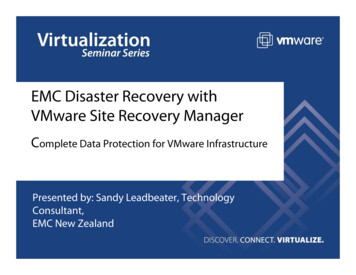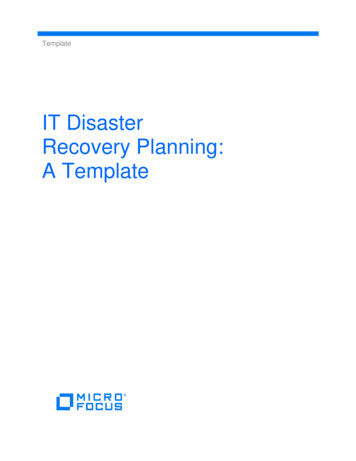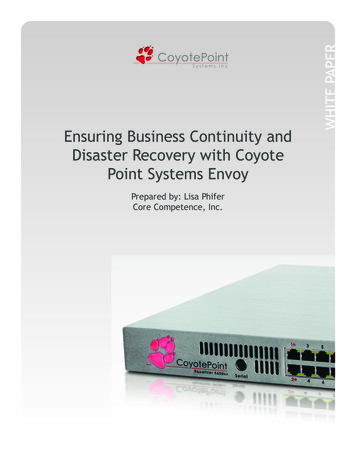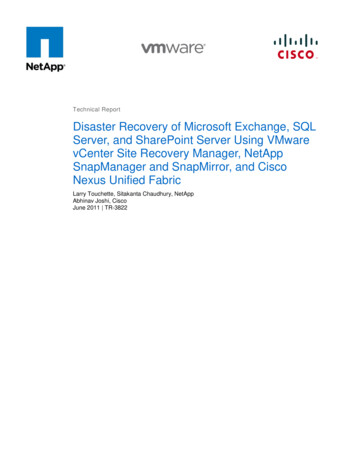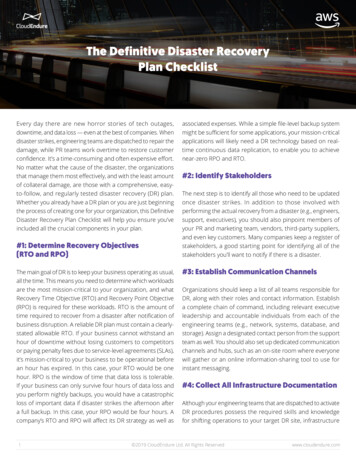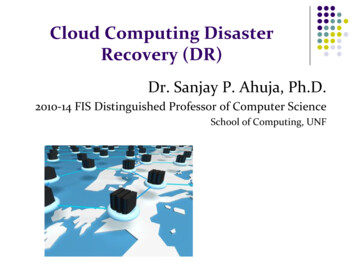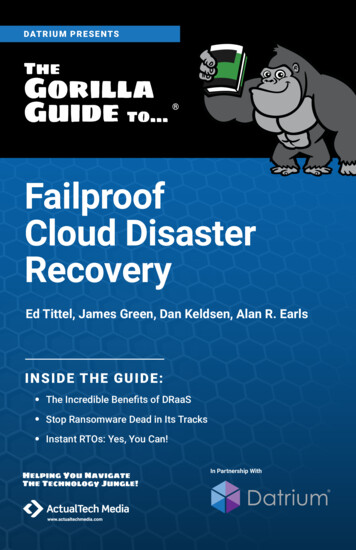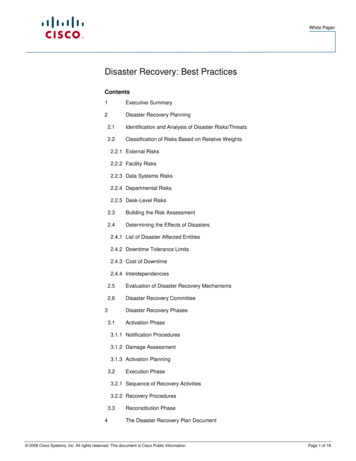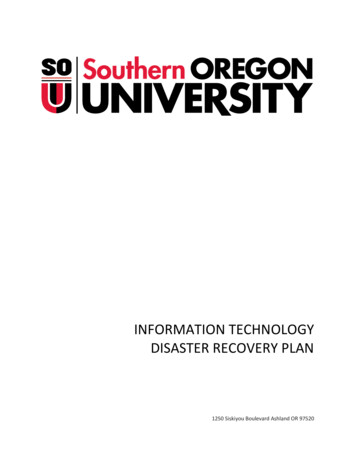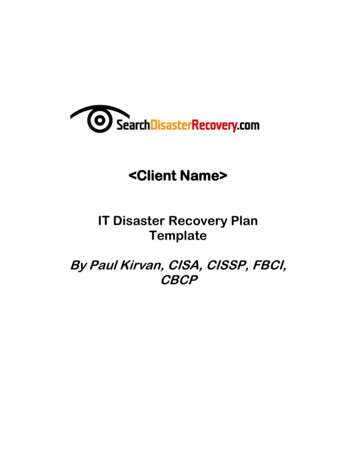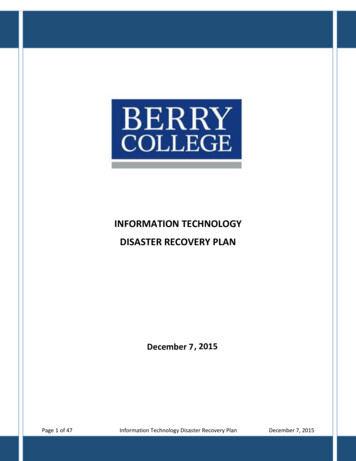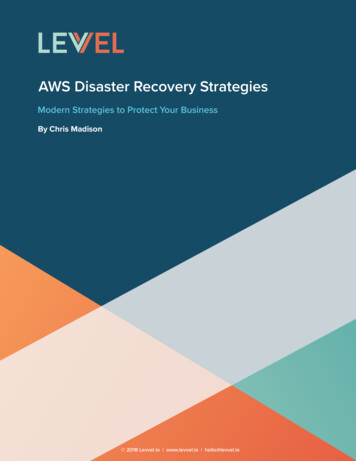
Transcription
AWS Disaster Recovery StrategiesModern Strategies to Protect Your BusinessBy Chris Madison 2018 Levvel.io www.levvel.io hello@levvel.io
AWS Disaster Recovery StrategiesModern Strategies to Protect Your BusinessAmazon Web Services (AWS) is a superior choice for organizations seekingto reduce technology costs by moving on-premise and collocated computeresources to the cloud. The primary benefit is that AWS entails a much lower totalcost of ownership (TCO) than self-hosted and collocated data centers, especiallywhen considering servers, network infrastructure, hardware, software, operatingsystems, power costs, cooling costs, and a variety of other components. The lowTCO of AWS not only makes it an excellent choice for any organization seekingto reduce their capital and operational expenses, it also serves as a valuabledisaster recovery (DR) platform.Disaster recovery is the essential business continuity and operational componentthat addresses an organization’s technical infrastructure and ability to survivean outage. Regardless of the cause, a disaster, to a business, is any eventthat results in the loss of data, limits the ability to satisfy customer requests, orthat disrupts income. The goal of disaster recovery is to salvage the technicaland operational assets needed to run a business after natural or man-madedisasters—with minimal manual input or nonstandard processes.The primary measures of disaster recovery mechanisms are:Recovery Time Objective (RTO): This metric is used to define the servicelevel of time to recovery or when a system must be available after a failure.For example, an eight-hour RTO indicates that the application must beavailable eight hours after failure occurs.Recovery Point Objective (RPO): RPO defines the amount of time thatdata is lost prior to the event. A one-hour RPO indicates that applicationoperational data must be available one hour or older from the point of failure.From a business goals perspective, typical trade-offs are analyzed in termsof down time, the longevity of data loss, and the cost of the disaster recoverysolution. That is, as RTO or RPO decrease, the disaster recovery solution typicallybecomes costlier.hello@levvel.io980.278.3065 2018 LEVVEL.IO ALL RIGHTS RESERVED2
Geographic Isolation in AWSDisasters are typically categorized as induced by nature or man. Man-madedisasters are generally confined to a smaller geographical area than naturaldisasters (the Chernobyl disaster of 1986 is a notable exception). Naturaldisasters include floods, hurricanes, and earthquakes, and impact large areas.AWS is designed around the idea of regions and Availability Zones. Regions areseparate and completely independent geographic areas where AWS provideshosting facilities. Each region contains two or more Availability Zones for faulttolerance. Availability Zones are located within the same region, but in differentlocations (e.g., floodplains, fault zones) to survive local natural and man-madedisasters. Availability Zones are connected to each other within a region andprovide inter-regional communication capabilities.The AWS region and availability zone concepts lay the foundation for aneffective, fault-tolerant disaster recovery platform.Disaster Recovery StrategiesDue to the variability of RTO and RPO requirements, there are a variety ofdisaster recovery strategies employed at the enterprise level. Referencing thediagram below, on the left are solutions (Backup & Restore, Pilot Light) that tendto have high RTO and RPO and thereby lower cost. As one progresses to theright of the diagram (Warm Standby, Multi-Site), RTO and RPO are minimal, buthave a greater solution cost.The diagram above identifies four general strategies for disaster recoverysolutions and illustrates the relative cost size of each extreme.hello@levvel.io980.278.3065 2018 LEVVEL.IO ALL RIGHTS RESERVED3
Backup & RestoreThe Backup & Restore strategy is a common DR pattern that is typically cheapbut accompanied by high RPO and RTO. The canonical example is data beingbacked up onto tape and that tape archive being stored for some amount oftime; these tapes are stored off-site in a facility specifically designed to maintaindigital archives.AWS provides a variety of low-cost options to support this DR strategy. Generally,the AWS Simple Storage Solution (S3) is used to store objects in the cloud. S3 isa powerful and low-cost storage solution with 11 9s durability (99.999999999%durable storage solution). In other terms, one may lose one object every 10million years on average. As a companion service, AWS Glacier offers lowcost archiving of infrequently accessed data. S3 lifecycle operations mayautomatically archive data from an S3 bucket into AWS Glacier and enforcecorporate disposition policies for compliance purposes.Besides direct Internet and VPN connectivity to AWS to access S3 storagebuckets, corporate data centers have several other options. These include DirectConnect, the AWS Storage Gateway, and, for extremely large data sets, Snowball.Direct Connect: Provides a direct, dedicated connection from a data centerto AWS via a controllable telco infrastructure. In many cases, Direct Connectprovides a more reliable and consistent network experience over standardInternet connectivity. Direct Connect provides improved connectivity,reliability, and capability for storage solutions over internet-based solutionsalone.hello@levvel.io980.278.3065 2018 LEVVEL.IO ALL RIGHTS RESERVED4
Storage Gateway: The storage gateway connects the corporate data centerto cloud-based storage solutions—namely, S3 and Glacier. There are threeStorage Gateway solutions:Gateway-cached volumes: This solution mounts to on-premise computeresources as an ISCSI disk. The Storage Gateway caches frequentlyaccessed data on-premises. However, all data is stored in an S3 bucket.Gateway-stored volumes: The stored volumes solution stores data onpremises for low latency access and replicates all data to S3. Replicationmay be synchronous or asynchronous.Gateway-virtual tape library: The virtual tape library (VTL) stores tapearchives in S3 and Glacier, depending on lifecycle configuration.Snowball: Snowball is a batch cloud transfer solution for very large data sets.Snowball reduces the cost and time necessary to transfer data sets in thepetabyte range. AWS sends the customer a Snowball device, the customerloads data onto the Snowball device and ships it back to AWS, and AWSloads the data directly into the customer’s S3 environment.A relatively new solution from AWS is the File Gateway solution. Similar toStorage Gateway, File Gateway is deployed on-premise as a virtual machine. TheFile Gateway integrates with the corporate data center through NFS. Corporatecompute resources mount the NFS file system to store and retrieve files. Storedfiles are replicated to AWS and stored in S3 where lifecycle policies manage thefiles’ disposition.S3 buckets are regional assets, meaning that the S3 bucket is located andaddressable through a specific AWS region. To increase durability andsurvivability of critical business data, S3 supports copying data betweenbuckets in different regions through Cross-Region Replication. S3 buckets maybe configured to automatically and asynchronously copy new objects acrossregions. Some customers leverage Cross-Region Replication to ensure datasurvivability across multiple regions.Within the context of the Backup & Recovery strategy of disaster recovery, AWSoffers several solutions, ranging from direct internet connectivity to an S3 bucketto using Snowball to transfer petabytes worth of information into the cloud.hello@levvel.io980.278.3065 2018 LEVVEL.IO ALL RIGHTS RESERVED5
Pilot Light StrategyThe Pilot Light strategy takes disaster recovery a little further, maintaining a smallfootprint in the AWS environment so that business operations may commence inAWS in the advent of a corporate data center failure.Metaphorically, a pilot light keeps a gas appliance (e.g., a water heater) primedfor use. When water needs to be heated, the water heater uses the pilot light toignite the furnace. Similarly, the basic level of application capability is duplicatedinto the cloud. When disaster strikes, the disaster recovery environment canbe brought online by leveraging the small amount of information stored in thecloud. In this case, however, information extends beyond the traditional object ordatabase storage mechanisms to also include snapshots of virtual images andsimilar elements of the application.At a minimum, application data must be replicated to the AWS disaster recoveryenvironment. Databases must be replicated or mirrored. Data may be replicatedto EC2 instances or AWS database services, depending on the type of databasein use. In the prior case, EC2 may be used for database software that ismanaged by the customer. The customer maintains the EC2 instance (patchesthe operating system and database software) and sets up replication betweenthe data center and the cloud instance. If the customer is leveraging AWSRDS, DynamoDB, or Redshift, AWS manages the database instance, while thecustomer sets up replication between the corporate database to the AWS-basedDR database.However, many applications have application-specific logic and supportsoftware stacks that must also be replicated in the cloud-based DR environment.Maintaining up-to-date application stacks in AWS allows for the DR environmentto be brought online much more quickly than when building application stacksfrom scratch.There are two common approaches to creating application stacks in AWS. Thefirst is to create custom images in AWS by building the application stack ona base image (AMI) available from the AWS Marketplace. Once the image isconstructed, it may be referenced when manually initializing the environmentor through automation in CloudFormation templates. Note that these imagesmust be kept up-to-date with corporate data center operating system, patches,and application updates. Otherwise, the DR environment may not function asexpected.hello@levvel.io980.278.3065 2018 LEVVEL.IO ALL RIGHTS RESERVED6
The second approach is to migrate VMWare images directly into AWS. Onemethod to do that is to create Elastic Block Store (EBS) images from VMFSartifacts. VMFS stores block images of VMWare images and snapshots. Coupledwith the Storage Gateway, VMWare images and snapshots may be replicated tothe AWS DR environment. These images and snapshots may be stored as EBSfile system snapshots and from there, EC2 images may be created from thoseEBS artifacts.When the DR environment is needed, the images can be spun up and theenvironment prepared to assume the role of the corporate data center. Domainname service (DNS) can be manually or automatically pointed to the DRenvironment. Horizontal scaling can be achieved using Elastic Load Balancersand Auto Scaling Groups to right-size the fleet to meet demand. The databasemay require vertical scaling to handle the product load being placed on it.Finally, the AWS-based Disaster Recovery environment should be hosted ina different geographical region from the corporate data center. Inter-regionaldeployment of a disaster recovery environment is a best practice.hello@levvel.io980.278.3065 2018 LEVVEL.IO ALL RIGHTS RESERVED7
Warm Standby StrategyThe Warm Standby strategy takes the Pilot Light strategy a step further andmaintains a fully functional environment in the DR environment. However, fullyfunctional does not imply the DR environment is sized to handle production-leveltraffic. Because the DR environment is fully functional, it is commonly used as aQA, testing, or training environment by the organization.The warm standby strategy is conceptually outlined in the diagram below. Theproduction environment is hosted in the corporate data center, and DNS directsproduction traffic to the data center. The DR environment, running in AWS,maintains a running environment that matches production in terms of applicationsoftware versions and patches. However, the DR environment is not designed tohandle production-level traffic.When the disaster recovery environment is required to assume production-leveltraffic, DNS may be switched over to the DR environment. Prior to assumingproduction-level traffic, the environment must be modified to scale. The databaseshould be scaled vertically using larger EC2 instance types in order for it toproperly handle additional transactional traffic. Web and application serversshould be scaled horizontally (horizontal scaling is preferred over vertical scalingin AWS).hello@levvel.io980.278.3065 2018 LEVVEL.IO ALL RIGHTS RESERVED8
Scaling horizontally includes the use of Application Load Balancers and AutoScaling Groups (ASGs). Application Load Balancers distribute incoming HTTP/HTTPS traffic across all available targets (instances). Application Load Balancersalso monitor the health of each target and will only send requests to healthyhosts.An ASG maintains a logical collection of EC2 instances that have similarattributes and functions (e.g., web server, application server). An ASG ensures aminimum number of EC2 instances are available and provides the capability toelastically scale by adding and removing EC2 instances to match traffic patterns.ASGs manage EC2 instance lifecycles by user-defined rules. For example, ascaling rule might define that a new EC2 instance be added to the group whenCPU traffic exceeds 75%; another rule removes EC2 instances when averageCPU use is below 55%.Application Load Balancers and ASGs integrate together. The ASG will registerand deregister EC2 instances as they are available or are removed from service.hello@levvel.io980.278.3065 2018 LEVVEL.IO ALL RIGHTS RESERVED9
Multi-Site StrategyCommonly known as the ‘active-active’ configuration, the Multi-Site strategyprovides a fully functional and scalable disaster recovery environment thatoperates synchronously with the corporate data center. DNS may be configuredto route a portion of production traffic through both the DR and productionenvironments. In short, the DR environment performs much the same as theproduction environment.However, there are some differences. First, the application servers may pointto a single environment for database access. Applications leverage data storesfor transactional and persistent data necessary to function. That being said, it isbest to keep the production and DR databases synchronized, as this allows theapplications to leverage one database and fail over to the DR environment if theproduction database fails.Scalability is the next environment change to tackle. While running in parallelto the production environment, the DR environment may not be configuredto assume full production load. In such cases, Elastic Load Balancers, AutoScaling Groups, and other mechanisms may be leveraged to scale out the DRenvironment.SummaryThis paper has briefly discussed four general disaster recovery strategies andhow these strategies may be implemented on an AWS platform. Additionally,the paper has covered several AWS services that may contribute to a cloudbased disaster recovery platform. In all, the theme of this paper is that AWS isan extremely powerful and low-cost solution that demonstrates superior TCO fordisaster recovery solutions.hello@levvel.io980.278.3065 2018 LEVVEL.IO ALL RIGHTS RESERVED10
About LevvelLevvel helps clients transform their business with strategic consulting andtechnical execution services. We work with your IT organization, product groups,and innovation teams to design and deliver on your technical priorities.Levvel's cloud experts combine decades of traditional architecture, development,security, and infrastructure experience with a complete mastery of availableand emerging cloud offerings. Our client-centric approach focuses first onunderstanding your business needs and goals, then selecting the right cloudtechnology to make you efficient, agile, and scalable. We tailor custom solutionsto fit within your business processes, simultaneously reducing TCO anddowntime while increasing productivity, security, ROI, and speed to market.If you are interested in understanding how AWS may contribute to your businessthrough a disaster recovery infrastructure with reduced expenses, contact Levvelat hello@levvel.io.hello@levvel.io980.278.3065 2018 LEVVEL.IO ALL RIGHTS RESERVED11
The Pilot Light strategy takes disaster recovery a little further, maintaining a small footprint in the AWS environment so that business operations may commence in AWS in the advent of a corporate data center failure. Metaphorically, a pilot light keeps a gas appliance (e.g., a water heater) primed for use.
